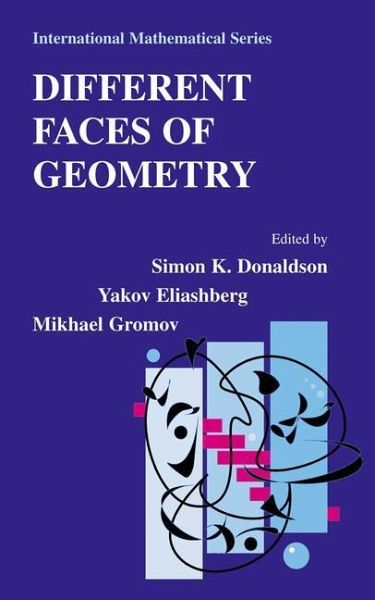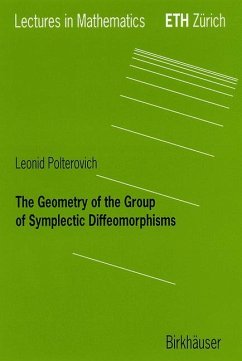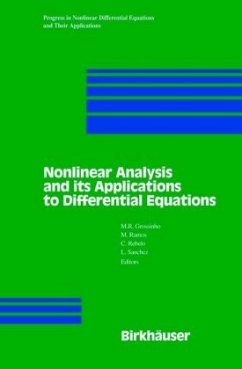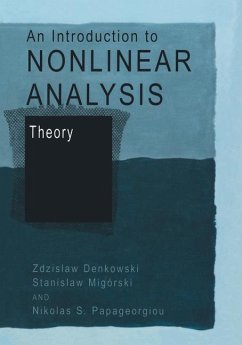
Different Faces of Geometry

PAYBACK Punkte
95 °P sammeln!
Different Faces of Geometry - edited by the world renowned geometers S. Donaldson, Ya. Eliashberg, and M. Gromov - presents the current state, new results, original ideas and open questions from the following important topics in modern geometry:Amoebas and Tropical GeometryConvex Geometry and Asymptotic Geometric AnalysisDifferential Topology of 4-Manifolds3-Dimensional Contact GeometryFloer Homology and Low-Dimensional TopologyKähler GeometryLagrangian and Special Lagrangian SubmanifoldsRefined Seiberg-Witten Invariants.These apparently diverse topics have a common feature in that they are a...
Different Faces of Geometry - edited by the world renowned geometers S. Donaldson, Ya. Eliashberg, and M. Gromov - presents the current state, new results, original ideas and open questions from the following important topics in modern geometry:
Amoebas and Tropical Geometry
Convex Geometry and Asymptotic Geometric Analysis
Differential Topology of 4-Manifolds
3-Dimensional Contact Geometry
Floer Homology and Low-Dimensional Topology
Kähler Geometry
Lagrangian and Special Lagrangian Submanifolds
Refined Seiberg-Witten Invariants.
These apparently diverse topics have a common feature in that they are all areas of exciting current activity. The Editors have attracted an impressive array of leading specialists to author chapters for this volume: G. Mikhalkin (USA-Canada-Russia), V.D. Milman (Israel) and A.A. Giannopoulos (Greece), C. LeBrun (USA), Ko Honda (USA), P. Ozsváth (USA) and Z. Szabó (USA), C. Simpson (France), D. Joyce (UK) and P. Seidel (USA), and S. Bauer (Germany).
"One can distinguish various themes running through the different contributions. There is some emphasis on invariants defined by elliptic equations and their applications in low-dimensional topology, symplectic and contact geometry (Bauer, Seidel, Ozsváth and Szabó). These ideas enter, more tangentially, in the articles of Joyce, Honda and LeBrun. Here and elsewhere, as well as explaining the rapid advances that have been made, the articles convey a wonderful sense of the vast areas lying beyond our current understanding.
Simpson's article emphasizes the need for interesting new constructions (in that case of Kähler and algebraic manifolds), a point which is also made by Bauer in the context of 4-manifolds and the "11/8 conjecture".
LeBrun's article gives another perspective on 4-manifold theory, via Riemannian geometry, and the challenging open questions involving the geometry of even "well-known" 4-manifolds.
There are also strikingcontrasts between the articles. The authors have taken different approaches: for example, the thoughtful essay of Simpson, the new research results of LeBrun and the thorough expositions with homework problems of Honda.
One can also ponder the differences in the style of mathematics. In the articles of Honda, Giannopoulos and Milman, and Mikhalkin, the "geometry" is present in a very vivid and tangible way; combining respectively with topology, analysis and algebra. The papers of Bauer and Seidel, on the other hand, makes the point that algebraic and algebro-topological abstraction (triangulated categories, spectra) can play an important role in very unexpected ways in concrete geometric problems." - From the Preface by the Editors
Amoebas and Tropical Geometry
Convex Geometry and Asymptotic Geometric Analysis
Differential Topology of 4-Manifolds
3-Dimensional Contact Geometry
Floer Homology and Low-Dimensional Topology
Kähler Geometry
Lagrangian and Special Lagrangian Submanifolds
Refined Seiberg-Witten Invariants.
These apparently diverse topics have a common feature in that they are all areas of exciting current activity. The Editors have attracted an impressive array of leading specialists to author chapters for this volume: G. Mikhalkin (USA-Canada-Russia), V.D. Milman (Israel) and A.A. Giannopoulos (Greece), C. LeBrun (USA), Ko Honda (USA), P. Ozsváth (USA) and Z. Szabó (USA), C. Simpson (France), D. Joyce (UK) and P. Seidel (USA), and S. Bauer (Germany).
"One can distinguish various themes running through the different contributions. There is some emphasis on invariants defined by elliptic equations and their applications in low-dimensional topology, symplectic and contact geometry (Bauer, Seidel, Ozsváth and Szabó). These ideas enter, more tangentially, in the articles of Joyce, Honda and LeBrun. Here and elsewhere, as well as explaining the rapid advances that have been made, the articles convey a wonderful sense of the vast areas lying beyond our current understanding.
Simpson's article emphasizes the need for interesting new constructions (in that case of Kähler and algebraic manifolds), a point which is also made by Bauer in the context of 4-manifolds and the "11/8 conjecture".
LeBrun's article gives another perspective on 4-manifold theory, via Riemannian geometry, and the challenging open questions involving the geometry of even "well-known" 4-manifolds.
There are also strikingcontrasts between the articles. The authors have taken different approaches: for example, the thoughtful essay of Simpson, the new research results of LeBrun and the thorough expositions with homework problems of Honda.
One can also ponder the differences in the style of mathematics. In the articles of Honda, Giannopoulos and Milman, and Mikhalkin, the "geometry" is present in a very vivid and tangible way; combining respectively with topology, analysis and algebra. The papers of Bauer and Seidel, on the other hand, makes the point that algebraic and algebro-topological abstraction (triangulated categories, spectra) can play an important role in very unexpected ways in concrete geometric problems." - From the Preface by the Editors














